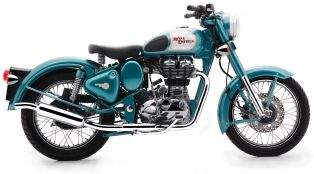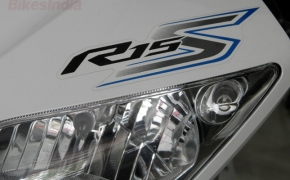 Yamaha initially launched the bike R15 in the year 2008, it turned out to be a spectacular motorcycle loved by most of the youngsters. They then updated the motorcycle in the year 2011, calling it the Yamaha R15 V2. It is a great motorcycle for a person who rides single and not for one who wants to carry a pillion rider for a long distance. Most of the potential customers wanted back the R15 with a single seat, so Yamaha decided to bring back the single seater R15 and named it the R15-S where S stands for standard (single seat).
Yamaha initially launched the bike R15 in the year 2008, it turned out to be a spectacular motorcycle loved by most of the youngsters. They then updated the motorcycle in the year 2011, calling it the Yamaha R15 V2. It is a great motorcycle for a person who rides single and not for one who wants to carry a pillion rider for a long distance. Most of the potential customers wanted back the R15 with a single seat, so Yamaha decided to bring back the single seater R15 and named it the R15-S where S stands for standard (single seat). Yamaha brought inside 3 new paint jobs for the motorcycle that made it distinctive from the outgoing R15 V2, the changes are not very major, but are in a noticeable quantity. let us find out what Yamaha R15-S has got for all of us-
Looks and Design:
 The R15S, upfront looks very similar to the R15 V2, a small noticeable change is that the headlamps are placed a little higher on the R15-S, so the R15 V2 gets a little more aggressive look. The R15S retains the Delta Box frame which the R15 V1 didn't have. The twin dragon eye shaped headlamps don't still feel outdated past 9 years.
The R15S, upfront looks very similar to the R15 V2, a small noticeable change is that the headlamps are placed a little higher on the R15-S, so the R15 V2 gets a little more aggressive look. The R15S retains the Delta Box frame which the R15 V1 didn't have. The twin dragon eye shaped headlamps don't still feel outdated past 9 years.Coming to the side profile, the whole difference can be noted, gone is the tall split pillion seat, and there is a single seat which is more convincing for a pillion to sit. The R15-S gets the same exhaust that the R15 V2 gets. Coming to the rear section it gets a grab rail for the pillion which was missing on the V2.
 The R15-S gets the same taillight as the R15 V1, but the tail light on the R15-S looks a little more clear. The rear indicators are placed a little closer, the motorcycle has lost the tire hugger as seen on the R15 V2, which is a sad thing. It now gets a single piece mud guard to which the number plate can be integer similar to what the version 1 had. The motorcycle comes in three colors, the Track White, Spark Green and the Adrenaline Red. My personal favorite among the three is the Track White.
The R15-S gets the same taillight as the R15 V1, but the tail light on the R15-S looks a little more clear. The rear indicators are placed a little closer, the motorcycle has lost the tire hugger as seen on the R15 V2, which is a sad thing. It now gets a single piece mud guard to which the number plate can be integer similar to what the version 1 had. The motorcycle comes in three colors, the Track White, Spark Green and the Adrenaline Red. My personal favorite among the three is the Track White. Instrument Panel and Switchgear:
 The Yamaha R15-S shares the same digital-analog instrument cluster with the R15 V1 and R15 V2. The instrument panel feels a little outdated compared to its rivals. The meter console bags two trip meters, speedometer, tachometer, reserve indicator, tell tale indicators, neutral position indicator, sensor fault indicator. The motorcycle also gets a lean angle sensor. The quality of materials used on the switchgear is phenomenal, the buttons feel nice and premium to touch and use. The rubber used on the handlebars also feel soft to use.
The Yamaha R15-S shares the same digital-analog instrument cluster with the R15 V1 and R15 V2. The instrument panel feels a little outdated compared to its rivals. The meter console bags two trip meters, speedometer, tachometer, reserve indicator, tell tale indicators, neutral position indicator, sensor fault indicator. The motorcycle also gets a lean angle sensor. The quality of materials used on the switchgear is phenomenal, the buttons feel nice and premium to touch and use. The rubber used on the handlebars also feel soft to use. Ergonomics:
 The motorcycle has a forward-biased riding position, it feels nice and sporty. For tall riders, it might be a little painful under traffic conditions. The rear set foot pegs give an aggressive and sporty feel to the rider. As a pillion, it feels like heaven when the co-rider sits behind, they have something to grab on to and more importantly the heads don't bang each other when the rider applies brake nor will the pillion experience any jerk under aggressive braking. The motorcycle weighs 134 kgs and is 2 kgs lighter to the V2. The motorcycle gets a 12-liter fuel tank capacity.
The motorcycle has a forward-biased riding position, it feels nice and sporty. For tall riders, it might be a little painful under traffic conditions. The rear set foot pegs give an aggressive and sporty feel to the rider. As a pillion, it feels like heaven when the co-rider sits behind, they have something to grab on to and more importantly the heads don't bang each other when the rider applies brake nor will the pillion experience any jerk under aggressive braking. The motorcycle weighs 134 kgs and is 2 kgs lighter to the V2. The motorcycle gets a 12-liter fuel tank capacity. Engine and Performance:
 The R15-S is powered by the same 150cc four-stroke, fuel injected, liquid cooled engine that is mated to a 6-speed gearbox. The engine churns out a power of 16.36 BHP at 8500 RPM and produces a peak torque of 15 Nm at 7500 RPM, where the R15 V2 produces a power figure of 16.8 BHP at 8500 RPM and it has the same torque figure.
The R15-S is powered by the same 150cc four-stroke, fuel injected, liquid cooled engine that is mated to a 6-speed gearbox. The engine churns out a power of 16.36 BHP at 8500 RPM and produces a peak torque of 15 Nm at 7500 RPM, where the R15 V2 produces a power figure of 16.8 BHP at 8500 RPM and it has the same torque figure. The power produced by the motorcycle is very gradual, there is ample amount of power whenever you need it. The riding experience is very smooth there are not much of jerks, hassles or vibrations felt even at speeds above 100kmph. The gear shifts also feel smooth. The lower end torque puts the traffic riding at ease. Heat produced is minimal.
Some problems I noticed are problems faced during aggressive overtakes, that is where the motorcycle shows the lack of power. The power brand lies between 5500RPM to 8500RPM, beyond which you are just over reviving the motorcycle, if the power production began at around 4000RPM, then the overtaking issues can be compromised. My most favorite part of the motorcycle is the downshifts, they are really good and effective.
Brakes and Suspension:
 The front end gets a 267mm single disc, and the rear gets a 220mm single disc. Being a proud owner of the R15 V2, I must say that the brakes that Yamaha provide are just phenomenal, the front brakes especially, they provide a good bite and feedback and do not lock up very easily. The rear brakes can be improved, they do lock up when they are applied aggressively.
The front end gets a 267mm single disc, and the rear gets a 220mm single disc. Being a proud owner of the R15 V2, I must say that the brakes that Yamaha provide are just phenomenal, the front brakes especially, they provide a good bite and feedback and do not lock up very easily. The rear brakes can be improved, they do lock up when they are applied aggressively. The motorcycle will not let you loose confidence when you brake at any point. The front end gets a 90/80 R17 tire sourced from MRF and the rear end gets a 130/70 R17 MED REV Z tire. The tires offer decent road grip even at corners. The front gets the outdated telescopic suspension and the rear gets a monoshock suspension. The ride quality for the pillion is far better when compared to the R15 V2. The suspensions do a decent job in absorbing the pot holes.
Pros-
* Single seat and grab rail.
* Engine quality.
* Low vibrations.
* Ride quality and experience.
* Still looks modern post 9 years.
Cons-
* Lack of features that modern bikes have.
* Lack of USD front fork.
* After Sale Service is slightly expensive.
Even though the Yamaha YZF-R15 is a 9-year old motorcycle, many still love it and prefer it over other motorcycles simply because of the trust Yamaha has created among their customers.* Single seat and grab rail.
* Engine quality.
* Low vibrations.
* Ride quality and experience.
* Still looks modern post 9 years.
Cons-
* Lack of features that modern bikes have.
* Lack of USD front fork.
* After Sale Service is slightly expensive.
Review By: Rishath Suresh
Photographs By: Aravindan






















